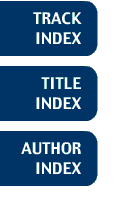
Track: Ecology, Conservation, and Archaeology
Louisiana Wetland Reserve Program (WRP) Demonstration Project

Jimmy JohnstonSteve Hartley , Antonio Martucci
The U.S. Department of Agriculture (USDA)/Natural Resources Conservation Service (NRCS), Alexandria, Louisiana; U.S. Fish and Wildlife Service (USFWS)/Ecological Services Office, Lafayette, Louisiana; The Nature Conservancy (TNC), Baton Rouge, Louisiana; and U.S. Geological Survey (USGS)/National Wetlands Research Center (NWRC), Lafayette, Louisiana, have developed a Wetland Reserve Program (WRP) demonstration using ArcView GIS Version 3.0 software. The goal of the demonstration project is to show GIS potential in assisting resource managers to determine land eligibility for WRPs. The WRP program is designed to take marginal agricultural land out of production; in exchange, landowners receive financial incentives to enhance these lands to wetlands. The first step in any GIS project is collecting or compiling data for input into the GIS and defining a pilot study area. Three 1:24,000-scale USGS quadrangles were selected as sample areas: Indian Lake, Newlight, and Saranac. The second step of the project involved organizing the digital data sets inside the GIS, customizing the user interface, and simplifying some complex and multiphase procedures specifically oriented to meet the needs of WRPs. The ArcView GIS internal programming language, Avenue, was used to customize menus, buttons, and tools for displaying thematic data sets and performing spatial analysis. Some of the features implemented include (a) updating tables by using a multi-input form, (b) updating layers by using on-screen digitizing, (c) creating a button to allow opening a double window view with linked zoom features, (d) simplifying buffering of geographic features and intersecting data layers, and (e) developing routines that clip data layers and perform acreage analysis. The project is constantly being updated with new data sets and WRP oriented spatial analysis routines. This presentation will provide an overview of the project and highlight its use by natural resource managers. Data sets now available are - WRP, Conservation Reserve Program (CRP), Farmers Home Administration (FmHA), and Wildlife Management Area (WMA) Lands - Soils and Geology (1:24,000) - Black Bear Habitat - The Louisiana GAP Vegetation Data - Classified Landsat 5 Thematic Mapper (TM) imagery along with other auxiliary data sets into twenty-three major vegetation groups and land use categories - SPOT Panchromatic (10m resolution) - Landsat 5 Thematic Mapper, False Color Composite 4,5,3 (1993) (25m resolution) - SPOT/TM Merge - USGS Digital Elevation Models (DEMs) - Mosaic of Scanned 1995 Color Infrared Photos - Mosaic of Scanned 1945-46 Black and White Historical Photos - Digital Orthophoto Quads (DOQs) (Newlight and Saranac); Mosaic of DOQs Quarters (Indian Lake) - Digital Raster Graphics (DRGs) - State and Parish Boundaries - USGS Hydrologic Units - Soil and Water Conservation District Boundaries - Oil and Gas Well Locations - USGS Digital Line Graphs (DLGs) (1:100,000) * Transportation * Hydrology * Pipelines * Railroads
Jimmy Johnston
USGS/BRD/NWRC
700 Cajundome Blvd
Lafayette, LA 70506
USA
Telephone: (318) 266-8500 x8556
Fax: (318) 266-8616
E-mail: jimmy_johnston@usgs.gov